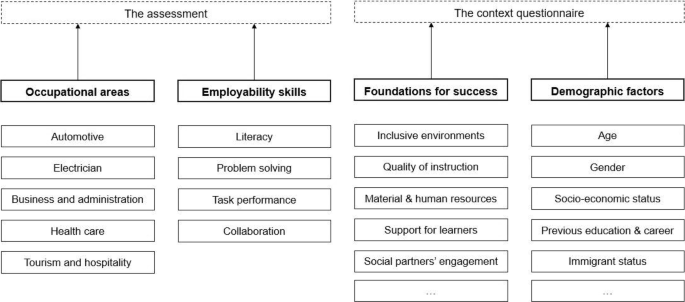
Evidence based approaches for enhancing vocational education worldwide
The PISA-VET initiative is an OECD-led project that aims to evaluate the skills of learners nearing completion of their VET programs in five specific occupational areas: Automotive Technician, Business and Administration, Electrician Craft/Industry, Healthcare (focusing on Nursing Assistants), and Tourism and Hospitality1. This initiative is an important step in taking VET education in the spotlight of international policy attention. The proposed framework is explicitly focused on specific occupations, unlike other large-scale assessments that focus on generic (and more rarely on specific) competencies, but usually within the general tracks of compulsory education. Within each of the five areas, the assessments focus on occupation-specific skills that are or should be the focal outcomes of VET programs. Aside from the occupation-specific skills, the assessment will capture a set of foundational, transversal competencies that were deemed as relevant across the five occupational areas —these “employability skills” (collaboration, literacy, problem solving and task performance). The components of PISA-VET were included in Fig. 1. The current paper will present potential benefits of PISA-VET and will critically examine the challenges.

Components of the PISA-VET assessment. It presents the main elements targeted by the PISA-VET assessment.
PISA-VET introduces some fundamentally new elements that set it apart from existing large-scale assessments like PISA and PIAAC. First, PISA-VET targets a population that has been largely overlooked by previous large scale educational assessment initiatives. Although the percentage of workforce undergoing VET education varies between countries, OECD2 reports that approximately one third of individuals aged between 25 and 34 have a vocational qualification as their highest education. Thus, PISA-VET represents the first standardized educational testing initiative that will provide information about this understudied segment of the future workforce while it still attends formal education. A potentially hindering factor in the generalizability of findings based on the roll-out of the PISA-VET assessment consists in the age range of the targeted population. More specifically, VET programs also include students that have ages that fall outside the targeted age-range (18-20 years).
Second, PISA-VET shifts the assessment focus from academic skills (mathematics, reading, science) to vocational education and training outcomes (such as occupation-specific skills and competencies), which have been historically underrepresented in global educational assessment initiatives. This is significant because it recognizes that learning pathways are diverse and potentially unique for different career paths. Consequently, vocational students require an evaluation that aligns with the skills they are building for becoming part of the active workforce, including employability skills, not just academic knowledge.
Third, PISA-VET introduces a focus at the intersection of education and employment–relevant skills. The merging of the two broad assessment domains (occupation-specific skills and employability skills) brings a new level of insight into how vocational programs can better prepare students for an evolving job market. By capturing both occupation-specific and universally required constructs (employability skills), PISA-VET provides a comprehensive assessment framework that evaluates the preparedness of VET students for the workforce, ensuring they possess not only technical expertise but also the adaptable, transferable skills necessary for success in a rapidly changing labor market.
Fourth, the PISA-VET introduces not only a simulation-oriented assessment but also includes hands-on demonstrations, enabling a more valid and realistic measurement of the key skills and competencies it focuses on. PISA-VET includes digitalized simulations and demonstrations of occupation-specific skills. Simulations include simplified representations of occupation-specific processes that the prospective incumbents are expected to master. For example, simulations employed for automotive technicians might include items requiring the test-takers to perform various measurements using specific instruments (e.g., how to measure the voltage on a connector pin). Live or recorded demonstrations will consist of the test-taker being required to perform various tasks, such as inspecting an automobile using the manufacturers’ instruction sheets. The importance of this innovation is twofold: (1) it has the potential to emulate real-world settings, potentially increasing the validity and relevance of the assessment results and (2) it has the potential to increase the participants’ engagement in completing the assessment, resulting not only in more accurate estimations of the focal skills but also in increased participation and completion rates.

